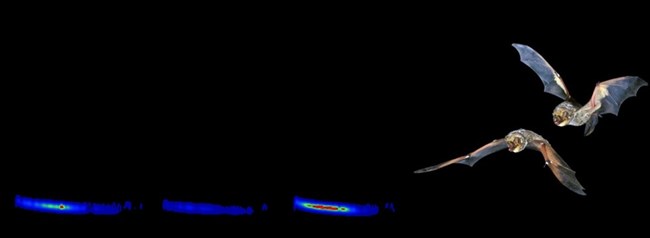Part of a series of articles titled The Midden - Great Basin National Park: Vol. 15, No. 1, Summer 2015.
Article
Park Prepares for 2015 Bat Surveys
This article was originally published in The Midden – Great Basin National Park: Vol. 15, No. 1, Summer 2015.

White-nose syndrome (WNS) is a serious disease affecting North American bats. It is caused by the fungus Pseudogymnoascus destructans and has resulted in the death of millions of bats in the United States and Canada. Bats are crucial to ecosystem function and provide billions of dollars per year to agriculture in insect suppression services alone. Despite efforts to contain it, WNS continues to spread. The National Park Service (NPS) has funded a proactive effort to minimize the impacts of white-nose syndrome on bats.
Part of the NPS effort focuses on education and outreach. Visitors to Lehman Caves are screened to determine if clothing, shoes, or equipment have been in caves or mines. If so, visitors are required to change or disinfect these items before entering the cave. The other part of the NPS effort focuses on inventory and monitoring. Park biologists, in cooperation with Nevada Department of Wildlife, are collecting baseline data on bat communities, using a combination of survey methods including mist netting, acoustic surveys, radio telemetry, and Passive Integrated Transponder (PIT) tagging. These methods address questions related to species diversity, habitat use, survival, abundance, and home ranges.

An exciting find from last year’s bat surveys was the capture of 34 bats exiting Lehman Caves. Townsend’s big eared bats are obligate cave and mine dwellers. They use specific microclimates in caves and mines for hibernation, parturition, and rearing their young. The high proportion of females and juveniles captured at Lehman Caves suggests this cave is a maternity colony. With over 30,000 visitors passing through Lehman Caves, more information is needed to better manage visitation and protect bats.
Park biologists will travel to Colorado to learn PIT tagging techniques from Colorado Parks and Wildlife biologists. These techniques will be used to better understand bat survival, home range, and seasonal activity Townsend’s big eared bat (Corynorhinus townsendii) and full spectrum call pattern. patterns. This data will be used to inform cave management decisions, minimizing the impacts of visitation on bats. Bats will be tagged and monitors set up at cave entrances. When a bat enters or exits the cave, their unique identification number, date, and time will be recorded. Nevada Department of Wildlife biologists will assist with radio telemetry studies. This will allow individual bats to be tracked, documenting their foraging patterns, home range, and roost locations.
If you are interested in bats, the park needs your help. We will hold two bat surveys open to the public. These will be held at Lehman Cave (July 21) and Upper Pictograph Cave (August 1). You are welcome to attend to see bats first hand and learn about the importance of bats in our ecosystems. Biologists will be conducting mist net and acoustic surveys. For more information contact Bryan Hamilton at 775-234-7563 or email Bryan Hamilton.
Last updated: June 18, 2024
